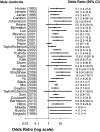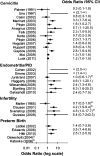Mycoplasma genitalium: should we treat and how?
- PMID: 22080266
- PMCID: PMC3213402
- DOI: 10.1093/cid/cir702
Mycoplasma genitalium: should we treat and how?
Abstract
Mycoplasma genitalium is associated with acute and chronic urethritis in men. Existing data on infection in women are limited and inconsistent but suggest that M. genitalium is associated with urethritis, cervicitis, pelvic inflammatory disease, and possibly female infertility. Data are inconclusive regarding the role of M. genitalium in adverse pregnancy outcomes and ectopic pregnancy. Available data suggest that azithromycin is superior to doxycycline in treating M. genitalium infection. However, azithromycin-resistant infections have been reported in 3 continents, and the proportion of azithromycin-resistant M. genitalium infection is unknown. Moxifloxacin is the only drug that currently seems to uniformly eradicate M. genitalium. Detection of M. genitalium is hampered by the absence of a commercially available diagnostic test. Persons with persistent pelvic inflammatory disease or clinically significant persistent urethritis or cervicitis should be tested for M. genitalium, if possible. Infected persons who have not previously received azithromycin should receive that drug. Persons in whom azithromycin therapy fails should be treated with moxifloxicin.
Figures


References
-
- Tully JG, Taylor-Robinson D, Cole RM, Rose DL. A newly discovered mycoplasma in the human urogenital tract. Lancet. 1981;1:1288–91. - PubMed
-
- Fraser CM, Gocayne JD, White O, et al. The minimal gene complement of Mycoplasma genitalium. Science. 1995;270:397–403. - PubMed
-
- Gibson DG, Benders GA, Andrews-Pfannkoch C, et al. Complete chemical synthesis, assembly, and cloning of a Mycoplasma genitalium genome. Science. 2008;319:1215–20. - PubMed
-
- Palmer HM, Gilroy CB, Furr PM, Taylor-Robinson D. Development and evaluation of the polymerase chain reaction to detect Mycoplasma genitalium. FEMS Microbiol Lett. 1991;61:199–203. - PubMed
Publication types
MeSH terms
Substances
Grants and funding
LinkOut - more resources
Full Text Sources

